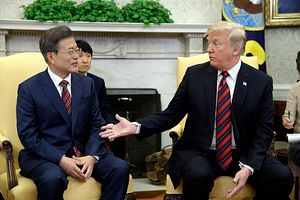The United States’ post-Singapore summit engagement with North Korea is in large measure being dictated by President Donald Trump’s perception of what Kim Jong Un agreed to behind closed doors. But whatever chasm exists between Trump and Kim’s understanding of what comprises a deal, the United States must navigate another serious gap between public opinion in its own country and in South Korea.
At home, Trump’s proclivity for salesmanship has compelled him to oversell his diplomatic feat — by suggesting that a potential deal, however laudable, is in the bag. His political line is affixed to the fact that he has been able to avert catastrophic war, thus making more concrete the possibility that the United States will be able to bring its troops home in the not-too-distant future. Trump’s breakthrough may pan out in the coming years, but for now, the real negotiations are only just beginning.
The broader point being missed here is that U.S. leadership must not just incentivize North Korea to follow through but also must mobilize allies and partners to stick with a common strategy as well. Trump is not simply a CEO — his preoccupation should not exclusively be the United States’ bottom line but ought to also encompass bringing allied countries’ views closer into alignment with our own.
Since Kim Jong Un’s January 1 peace address, and more markedly so after the first inter-Korean summit on April 27, there seems to be a growing disjuncture between the views of the American and South Korean publics on how to manage the Kim regime. This is noteworthy because negotiations with North Korea are not simply a two-way transaction. Rather, South Korean and other Asian audiences will view the way American policymakers manage and talk about negotiations with North Korea as a barometer of the United States’ willingness to be a leading force in the region.
American and South Korean leaders alike claim that the U.S.-ROK alliance is stronger than ever since it was formalized after the Korean War resulted in the 1953 Armistice. Yet, today, the gap between where American and South Korean people reside in their perceptions of the level of threat that North Korea poses is jarring. After a year of bellicose rhetoric and panic-inducing tensions, the April inter-Korean summit prompted a significant reappraisal amongst South Koreans of Kim’s intentions. A poll that South Korea’s MBC news station conducted in May 2018 found that more than 78 percent of South Koreans now view Kim as trustworthy. The second summit in late May did nothing to alter that overwhelming verdict on the North Korea leader.
In sobering contrast, coordinated polls in the United States, including the University of Maryland Critical Issues Poll, highlight enduring skepticism on the part of Americans. After the June 12 Singapore summit, the number of Americans who said the risk of military confrontation with North Korea is the same or higher than it was a year ago far outweighed those who said the risk is now lower (62 percent in contrast with 27 percent). Similarly, in a non-scientific poll of 65 experts and informed members of the public at the Center for a New American Security’s annual conference in June, approximately 60 percent of respondents voted that the geopolitical climate on the Korean Peninsula would remain at status quo for the next two decades The second most popular response was regime collapse and internal destabilization in North Korea, which nearly a quarter of respondents selected.
Going forward, how should the current and future U.S. administrations manage the widening gap between what the American and South Korean publics believe has happened in the past six months or two and a half years? More importantly, can an alliance exist without the broader substructure of consensus between the two publics about what the future will and should look like?
The key remains the U.S. president’s ability to articulate a clear vision to both the American public and the South Korean public of what the future of the alliance will look like. The Moon and Trump administrations are having regular, high-level, private conversations, but they need to amplify public discussions, too. There are a few concrete steps that the Trump administration can take.
First, the Trump administration must refrain from sowing further doubt about the alliance because of its alleged costs or the notion that peace is assured. The president’s comments to that effect after the summit may have been intended to encourage Kim, but they may also have discouraged the community of people in both South Korea and the United States who have worked the hardest to achieve mutual security through close cooperation.
Additionally, during the regular, high-level State and Defense meetings that occur every year in each country, senior officials from both the United States and South Korea should engage in town-hall meetings that set forth a common vision for the alliance as peace with North Korea is tested. Similarly, once in place, Ambassador Harry Harris will be in a great position to conduct such focused talks in South Korea as well.
Finally, increase cultural and educational exchanges between U.S. and South Korean students, teachers, and experts. Offering South Korea-based North Korean defectors more opportunities to study in the United States, as the Fulbright Program has begun to do, would be a good place to start.
An important part of Trump’s responsibility as president is to manage expectations and to explain clearly to public audiences, both at home and abroad, exactly what the United States is trying to achieve on the Korean Peninsula and how it will continue to be a leader in Northeast Asia. Absent this kind of vision, the American public at least will likely remain unconvinced that the Trump-Kim summit has truly set the United States on a path to a breakthrough in relations with North Korea.
Kristine Lee is a research associate and Melodie Ha is a Joseph S. Nye, Jr., National Security intern with the Asia-Pacific Program at the Center for a New American Security.

































